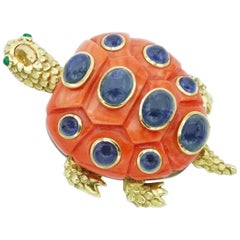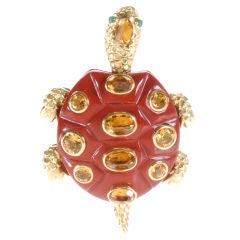Seaman Schepps Turtle
Recent Sales
Vintage 1970s American Brooches
Coral, Emerald, Blue Sapphire, Yellow Sapphire, Yellow Gold
American Brooches
Carnelian, Citrine, Emerald, 18k Gold
Vintage 1940s American Cluster Rings
Sapphire, 18k Gold
Vintage 1960s American Brooches
Citrine, 18k Gold, Yellow Gold
21st Century and Contemporary American Brooches
Citrine, Emerald, 18k Gold
21st Century and Contemporary American More Necklaces
Malachite, 18k Gold
Seaman Schepps for sale on 1stDibs
A scrappy, self-made artist who transformed turbo shells into decadent earrings and crystal chessmen into bold bracelets, Seaman Schepps (1881–1972) tirelessly worked his way up from the tenements of New York’s Lower East Side to become “America’s Court Jeweler.”
Born to immigrant parents who named him for the Seamen’s Bank for Savings that his mother could see from the hospital — or so the legend goes — Schepps dropped out of school at the age of 14 and never had any formal jewelry training. He later moved to California, where he opened his first jewelry shop in 1904. In 1921, he returned to New York to build on the success he’d begun to enjoy as a jeweler on the West Coast, but it wasn’t long before his Manhattan house, which counted Broadway stars and theater patrons among its clientele, was hit hard by the stock market crash of 1929. Schepps used this disruption to rethink his approach to jewelry, debuting a new store in 1934 on Madison Avenue, where he would make his mark in playful custom adornments.
While many high-end jewelers of his era focused on the purest and most valuable gemstones, Schepps chose his materials for their color and shape, elevating flawed stones others disregarded in collage-like formations involving unconventional materials such as fine wood, coral, seashells and flea-market finds. Passersby of his New York City shop could find a frog-shaped brooch carved from rosewood, a vintage snuff bottle broken into links for a bracelet and loose-drilled pearls plugged with diamonds. Schepps’s whimsical pieces found fans in fashion icons who appreciated his unique statements, including Doris Duke, Andy Warhol and the Duchess of Windsor.
Following Schepps’s death in 1972, his daughter, jewelry designer Patricia S. Vaill, ran the jewelry house for two decades before it was taken over by Jay Bauer and Anthony Hopenhajm of Trianon jewelry. Following the closure of the company’s Park Avenue store in November 2020, sales for Seaman Schepps is now based in its boutique location out of Palm Beach, Florida, where the legendary brand carries forth its founder’s spirited designs.
On 1stDibs, find a distinctive collection of vintage Seaman Schepps jewelry, including brooches, bracelets and other accessories.
Why Gold Shines in Jewelry Craftsmanship
Gold is the feel-good metal, the serotonin of jewelry. Wear vintage and antique gold necklaces, watches, gold bracelets or gold rings and you feel happy, you feel dressed, you feel, well, yourself.
Gold, especially yellow gold, with its rich patina and ancient pedigree going back thousands of years, is the steady standby, the well-mannered metal of choice. Any discussion of this lustrous metal comes down to a basic truth: Gold is elementary, my dear. Gold jewelry that couples the mystique of the metal with superb design and craftsmanship achieves the status of an enduring classic. Many luxury houses have given us some of our most treasured and lasting examples of gold jewelry over the years.
Since its founding, in 1837, Tiffany & Co. has built its reputation on its company jewelry as well as its coterie of boutique designers, which has included Jean Schlumberger, Donald Claflin, Angela Cummings and Elsa Peretti. There are numerous gold Tiffany classics worth citing. Some are accented with gemstones, but all stand out for their design and the workmanship displayed.
For the woman who prefers a minimalist look, the Tiffany & Co. twist bangle (thin, slightly ovoid) is stylishly simple. For Cummings devotees, signature pieces feature hard stone inlay, such as her pairs of gold ear clips inlaid with black jade (a play on the classic Chanel black and tan), or bangles whose design recalls ocean waves, with undulating lines of lapis lazuli and mother-of-pearl. And just about any design by the great Jean Schlumberger is by definition a classic.
Even had he eschewed stones and diamonds, Southern-born David Webb would be hailed for the vast arsenal of heavy gold jewelry he designed. Gold, usually hammered or textured in some manner, defines great David Webb jewelry. The self-taught jeweler made very au courant pieces while drawing inspiration from ancient and out-of-the-way sources — East meets West in the commanding gold necklaces made by Webb in the early 1970s. The same could be said for his endlessly varied gold cuffs.
In Europe, many houses have given us gold jewelry that sets the highest standard for excellence, pieces that were highly sought after when they were made and continue to be so.
Numerous designs from Cartier are homages to gold. There are the classic Trinity rings, necklaces and bracelets — trifectas of yellow, white and rose gold. As a testament to the power of love, consider the endurance of the Cartier Love bracelet.
Aldo Cipullo, Cartier’s top in-house designer from the late 1960s into the early ’70s, made history in 1969 with the Love bracelet. Cipullo frequently said that the Love bracelet was born of a sleepless night contemplating a love affair gone wrong and his realization that “the only remnants he possessed of the romance were memories.” He distilled the urge to keep a loved one close into a slim 18-karat gold bangle.
BVLGARI and its coin jewelry, gemme nummarie, hit the jackpot when the line launched in the 1960s. The line has been perennially popular. BVLGARI coin jewelry features ancient Greek and Roman coins embedded in striking gold mounts, usually hung on thick link necklaces of varying lengths. In the 1970s, BVLGARI introduced the Tubogas line, most often made in yellow gold. The Tubogas watches are classics, and then there is the Serpenti, the house's outstanding snake-themed watches and bracelets.
A collection called Monete that incorporated the gold coins is one of several iconic BVLGARI lines that debuted in the 1970s and ’80s, catering to a new generation of empowered women. Just as designers like Halston and Yves Saint Laurent were popularizing fuss-free ready-to-wear fashion for women on the go, BVLGARI offered jewels to be lived in.
Since Van Cleef & Arpels opened its Place Vendôme doors in 1906, collection after collection of jewelry classics have enchanted the public. As predominantly expressed in a honeycomb of gold, there is the Ludo watch and accessories, circa the 1920s, and the golden Zip necklace, 1951, whose ingenious transformation of the traditional zipper was originally proposed by the Duchess of Windsor. Van Cleef's Alhambra, with its Moroccan motif, was introduced in 1968 and from the start its popularity pivoted on royalty and celebrity status. It remains one of VCA’s most popular and collected styles.
Mention must be made of Buccellati, whose name is synonymous with gold so finely spun that it suggests tapestry. The house’s many gold bracelets, typically embellished with a few or many diamonds, signified taste and distinction and are always in favor on the secondary market. Other important mid-20th-century houses known for their gold-themed jewelry include Hermès and Ilias Lalaounis.
Find a stunning collection of vintage and antique gold jewelry on 1stDibs.

